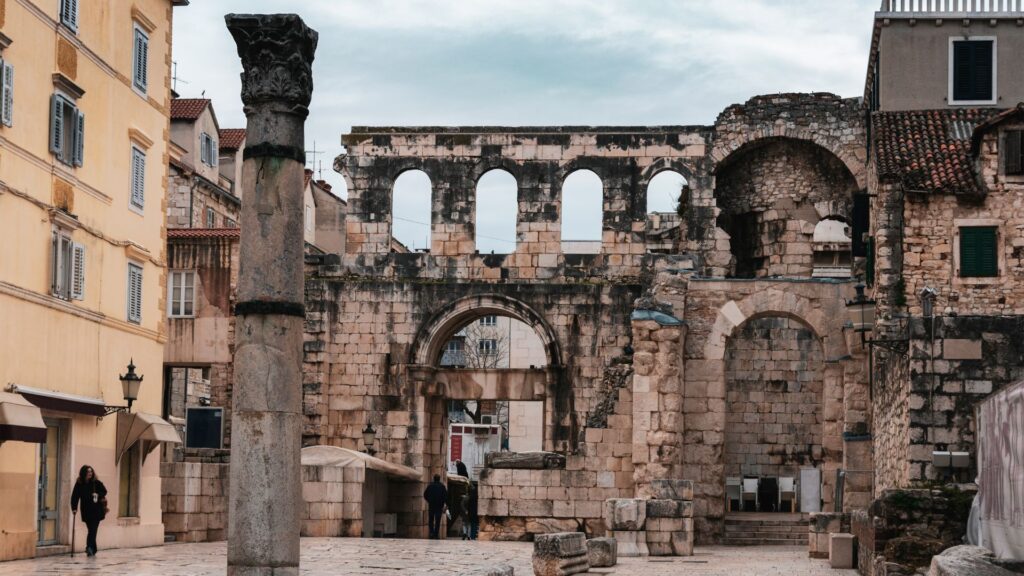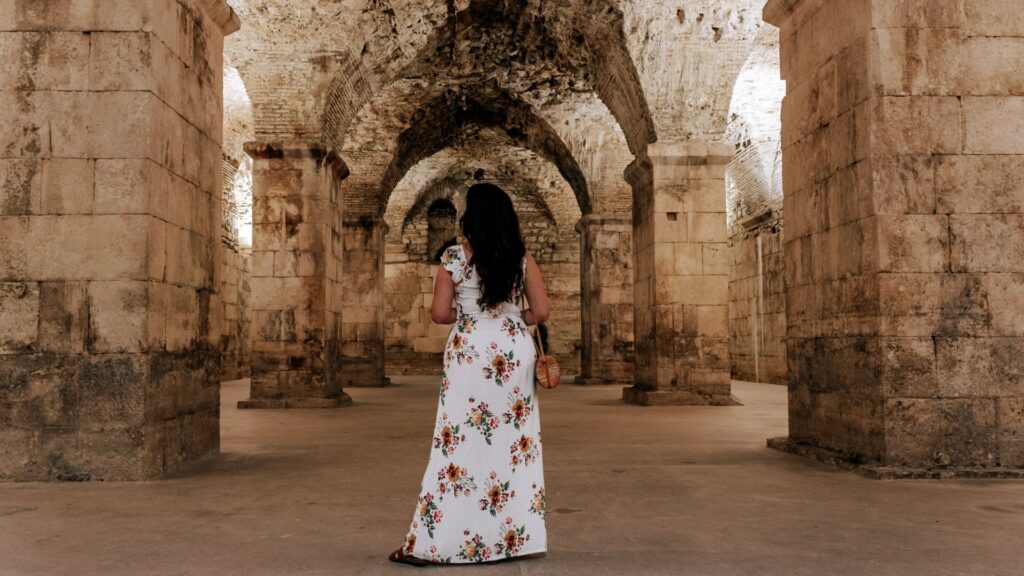Embark on a historical journey to Diocletian’s Palace, a remarkable testament to Roman architectural brilliance nestled in the heart of Split, Croatia. This ancient palace, dating back to the 4th century AD, stands as one of the most imposing and well-preserved Roman buildings in the world. A UNESCO World Heritage site, Diocletian’s Palace is not just a monument of the past; it’s a vibrant part of Split’s present, seamlessly woven into the city’s urban fabric.
As you wander through the palace’s labyrinth of stone-paved streets, you are walking in the footsteps of emperors. The grandeur of its walls, the intricacy of its arches, and the depth of its history resonate with every step. Here, the past comes alive amidst the buzz of modern city life, offering a unique blend of ancient history and contemporary culture. From the majestic peristyle and the Cathedral of Saint Domnius to the bustling shops and cafes within its walls, Diocletian’s Palace offers a captivating glimpse into the Roman way of life, preserved in the heart of Croatia.
This introduction to Diocletian’s Palace is your portal to exploring one of the most significant architectural treasures in the Mediterranean. It’s a journey that takes you back in time, immersing you in the legacy of the Roman Empire, yet allows you to experience the dynamic rhythm of modern-day Split. Whether you’re a history buff, architecture enthusiast, or simply in search of a unique travel experience, Diocletian’s Palace promises a journey that you won’t forget.
Diocletian’s Palace: A Testament to Roman Ingenuity
Nestled in the heart of Split, Diocletian’s Palace is not just an ancient structure; it’s the pulsating heart of the city. Built in the 4th century AD for the Roman Emperor Diocletian, the palace is one of the most well-preserved monuments of Roman architecture in the world. Its imposing walls and well-preserved buildings offer a glimpse into Roman life and the architectural prowess of the era.
Architectural Marvels of the Palace
The palace is a treasure trove of architectural marvels, from its grandiose peristyle courtyard to the majestic Cathedral of Saint Domnius, originally Diocletian’s mausoleum. Visitors can marvel at the intricate details of Roman columns, arches, and sculptures that adorn the complex. The underground cellars, once the foundation of the emperor’s quarters, provide insight into the palace’s original structure and function.

A Living Monument in Split
Unlike many ancient historical sites, Diocletian’s Palace is a living monument. Its ancient walls and buildings are integrated into the fabric of modern Split, housing shops, cafes, and residences. Walking through the narrow streets of the palace is a unique experience, where the past and present coexist seamlessly. The bustling atmosphere, with its blend of historical ambiance and contemporary culture, makes the palace a unique urban attraction.
Exploring the Historical and Cultural Significance
As a UNESCO World Heritage site, Diocletian’s Palace holds significant historical and cultural value. It’s a testament to the Roman Empire’s influence in the region and a focal point for understanding Croatia’s historical layers. The palace hosts various cultural events and exhibitions, further enriching visitors’ experiences with its historical narrative.

Conclusion: Diocletian’s Palace – A Journey into the Past, Alive in the Present
Diocletian’s Palace stands as a monumental reminder of Split’s rich history and Roman heritage. Visiting the palace is a journey through time, where every stone and corridor tells a story of ancient glory and architectural innovation. The fusion of historical monument and lively city life makes Diocletian’s Palace a unique destination, offering an experience that is both educational and immersive.
For history enthusiasts, architecture buffs, or anyone seeking to delve into the heart of Split’s cultural heritage, Diocletian’s Palace offers an unparalleled glimpse into the past, vibrantly alive in the present. It’s a place where history is not just preserved; it’s experienced in every step through its ancient passageways.
Do I need to purchase tickets to enter Diocletian’s Palace?
Entry to Diocletian’s Palace itself is free, as it is integrated into the city of Split. However, tickets may be required for specific attractions within the palace, such as the Cathedral of Saint Domnius and the underground cellars.
Are guided tours available for Diocletian’s Palace?
Yes, guided tours are available and highly recommended to fully appreciate the history and architecture of Diocletian’s Palace. These tours are offered in various languages and provide in-depth insights into the palace’s past and its significance.
Is photography allowed inside Diocletian’s Palace and its attractions?
Photography is generally allowed within Diocletian’s Palace and its open areas for personal use. However, photography rules may vary for specific attractions within the palace, such as the Cathedral of Saint Domnius and the underground cellars. It’s always a good idea to check for any photography restrictions at each site, especially for professional or commercial photography, which might require special permission.
Can visitors explore Diocletian’s Palace on their own, or is a guided tour necessary?
Visitors are welcome to explore Diocletian’s Palace on their own. The palace’s central location in Split makes it easily accessible and navigable for independent exploration. However, to gain a deeper understanding of the historical and architectural significance of the site, a guided tour is highly recommended. Guided tours offer valuable insights and stories that enhance the overall experience of visiting this historic landmark.
